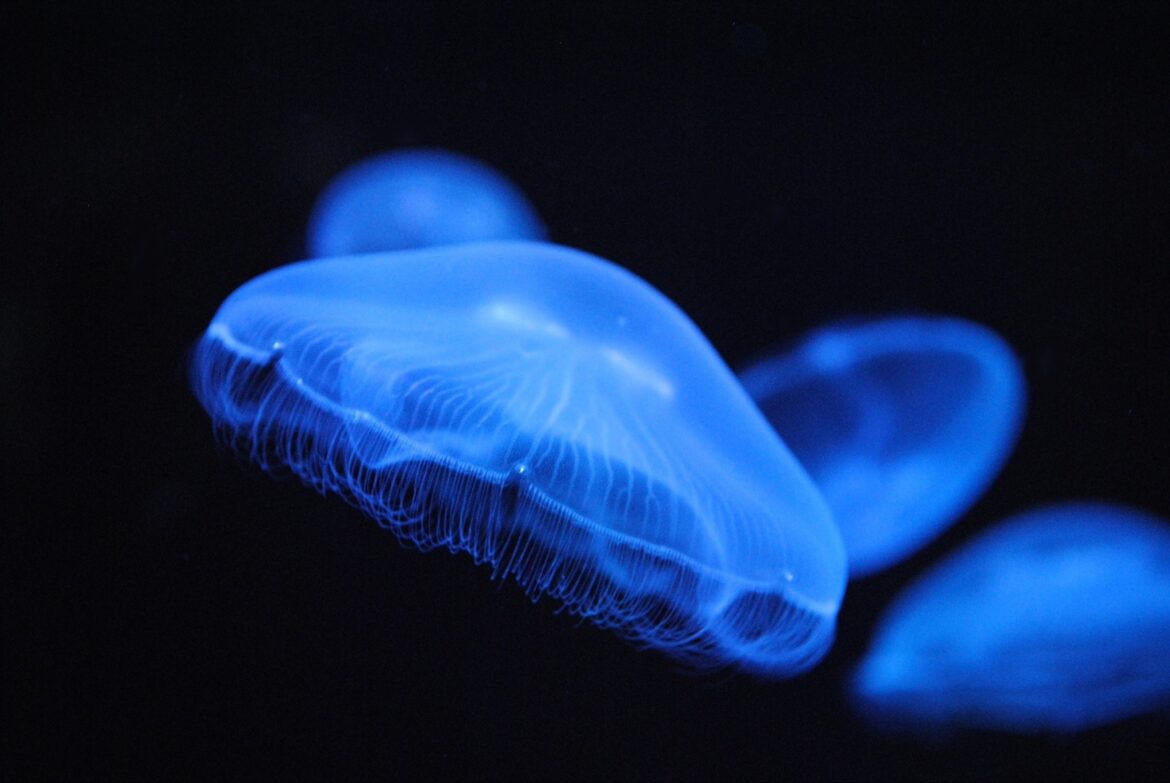As a marine heatwave grips the UK this July 2025, dramatic images of giant barrel jellyfish — some nearly a metre wide — washing ashore have caused alarm across coastal communities. The startling invasion isn’t just a summer oddity: it’s a visible sign of warming seas and a growing pattern shifting British shoreline ecosystems.
This comprehensive report explores what’s happening, why it’s happening, how to stay safe, and what it means for UK beaches in the years ahead.
A Quick Summary for Readers
Unusually warm sea temperatures (1.5–3 °C above average) have brought swarms of massive barrel jellyfish to UK coastlines — particularly in North Wales, Scotland, and Southern England. While these creatures usually pose minimal threat, there’s concern that more dangerous species like the Portuguese man o’ war could follow. Discover why this is happening, what precautions to take, and how it may signal long-term marine change.
What Are Barrel Jellyfish?
Barrel jellyfish (Rhizostoma pulmo) — aka “dustbin-lid” jellies — are large, umbrella-shaped creatures that can reach up to 1 metre in diameter. Their stings are mild to humans, but they can still cause skin irritation and alarm beach-goers.
Though common in deep, open waters, sightings close to shore are less usual — especially in such large numbers — making this a noteworthy event. AOL+3The Sun+3The Scottish Sun+3Scubaverse+1The Scottish Sun+1
Why Are They Washing Up Now?
1. Marine Heatwave Conditions
Met Office data confirm sea temperatures in regions like the English Channel, Celtic Sea, and Southern North Sea are currently between 1.5 °C and 3 °C above normal for early July — more typical of August warmth The Sun+1The Scottish Sun+1.
2. Shifting Currents
Warmer currents are driving deep-water species like barrel jellyfish toward coastlines, a phenomenon noted by marine zoologists. Frankie Hobro of Anglesey Sea Zoo comments that chillers are now turned on in May, not July The Sun+1The Scottish Sun+1.
3. Climate-Driven Marine Changes
Rising UK sea temperatures encourage early seasonal blooms, enabling species to reproduce closer to shore and potentially earlier in the summer The Scottish Sun+7The Sun+7Secret London+7.
Are These Jellyfish Dangerous?
Barrel Jellyfish
- Mild sting — more of an irritation than a hazard
- Still capable of affecting swimmers, especially ankles and feet
- Can look alarming due to size alone
Portuguese Man O’ War & Others
- Known for painful, blistering stings, often causing welts
- Typically ocean-dwelling but increasingly seen near UK beaches Yahoo+8The Sun+8Secret London+8The Sun+3AOL+3Yahoo News+3The Sun+2The Sun+2The Guardian+2
- Tentacles may stretch up to 30 feet and remain venomous even when detached
Real-Life Sightings in the UK
- North Wales: Swarms seen in Conwy, Rhyl, Rhos‑on‑Sea; a Rhos visitor described encountering jellies “larger than dustbin lids” The Sun+6The Sun+6The Scottish Sun+6
- Scotland (Ayrshire): Entire beaches deserted amid meter-wide barrel jellyfish on sands fccan.org.uk+12The Sun+12The Scottish Sun+12
- Cornwall & Isles of Scilly: Historic mauve stinger wash-ups continue, highlighting broader shifting marine trends Scubaverse+7The Sun+7The Sun+7
What This Means for UK Beachgoers
- Take Care Around the Shoreline
Even harmless species can sting if stepped on while wading. Avoid touching any jelly, dead or alive. - Use Protective Swimwear
Consider rash vests, swim socks, or wetsuits — especially for children. - Know Emergency Measures
If stung:- Rinse with sea water
- Remove tentacles carefully with a flat surface (e.g., credit card)
- Apply warm compresses and painkillers
- Seek medical help for severe reactions or difficulty breathing The Sun+6The Sun+6The Sun+6The Sun+1Secret London+1
Wider Impacts of Jellyfish Blooms
- Tourism disruption: families avoiding beaches reduces footfall and local revenue. Ayrshire beaches saw visitor decline when swarms appeared.
- Marine ecosystem shifts: jellyfish can consume zooplankton, disturbing food chains and hurting species like herring and mackerel.
- Impacts on industry: power stations and water filtration systems may be forced to shut down during mass blooms, as seen in Australia and rare cases in UK.
- Climate change indicator: escalating jellyfish blooms are a sign of warming seas — similar trends are noted globally in Spain, the Mediterranean, and parts of the US Facebook+2AOL+2The Sun+2.
Practical Tips for Safe Beach Visits
- Check local advisories: lifeguards or council websites may issue warnings.
- Avoid swimming during peak bloom hours: usually late morning and early afternoon.
- Pack a beach safety kit: vinegar, warm compress materials, and sunscreen.
- Educate your group: especially helpful when traveling with children.
FAQs
1. Why are jellyfish appearing earlier in the summer?
Sea temperatures are warming due to climate change, causing species that are usually deep-water or late-season to show up in early July Secret London+3The Sun+3The Scottish Sun+3.
2. Can a dead jellyfish still sting?
Yes — the stinging cells (nematocysts) can remain active even when the animal is dead. Handle carefully or avoid touching at all.
3. Are any UK jellyfish poisonous?
The Portuguese man o’ war and mauve stinger have painful venom. Barrel and moon jellyfish are generally harmless, but caution is still advised.
4. What should I do if someone is stung?
Rinse with seawater, remove tentacles gently, soak the area in warm water, take painkillers, and call NHS 111 or seek medical help for severe symptoms The SunThe Guardian+2The Sun+2The Sun+2.
5. Is this jellyfish surge permanent?
Scientists say jellyfish populations naturally fluctuate every 20 years, but warming seas and reduced predators may be increasing frequency and size of blooms The Sun+8Scubaverse+8The Guardian+8.
Final Thoughts
The surge of jellyfish on UK beaches this July is more than just a tourist inconvenience — it’s a tangible symptom of shifting marine environments. While barrel jellyfish pose limited danger, the rise of venomous species like the Portuguese man o’ war demands attention and caution.
This phenomenon highlights the urgent need for community awareness, environmental monitoring, and adaptive coastal management. As sea levels rise, these creatures may become a more common part of our summer experience — and preparing now can help keep our shores safe and welcoming.
🧾 Resources & References
- Met Office – UK Sea Surface Temperature Analysis (July 2025)
https://www.metoffice.gov.uk/research/climate/maps-and-data/sst - The Sun UK – Giant Jellyfish Sightings on British Beaches
https://www.thesun.co.uk/news/35787823/giant-jellyfish-invade-uk-beaches - Scubaverse – Marine Conservation Society Reports Jellyfish Blooms
https://www.scubaverse.com/marine-conservation-societys-report-shows-increase-in-jellyfish-sightings-on-uk-and-irish-shores - AOL News – Massive Jellyfish Sightings in England and Spain
https://www.aol.com/news/massive-jellyfish-spotted-england-beach-232712488.html - British Red Cross – Marine Life and Emergency First Aid Tips
https://www.redcross.org.uk/first-aid/learn-first-aid/jellyfish-sting
📘 Disclaimer
This article is intended for general informational purposes only. The content reflects available data and reporting at the time of writing and does not constitute scientific advice, medical guidance, or official government policy.
All sightings, climate data, and responses have been fact-checked using authoritative UK-based sources. Readers experiencing medical emergencies should contact NHS 111 or local services. For up-to-date marine warnings or beach safety alerts, consult your regional coastal authority or the UK Met Office.
The Breadline Bulletin is not responsible for third-party content linked in this article.
Internal Links from The Breadline Bulletin
- UK Food Prices Rise Again: What Shoppers Can Expect This Month
- Heatwave Alerts Issued Across the UK: What You Should Know
- Household Budget Tips for Beating the 2025 Cost Crunch
- Petrol Prices in the UK Spike — Save Money at the Pump
- Cyberattack on Marks & Spencer Sparks Security Concerns for Millions



